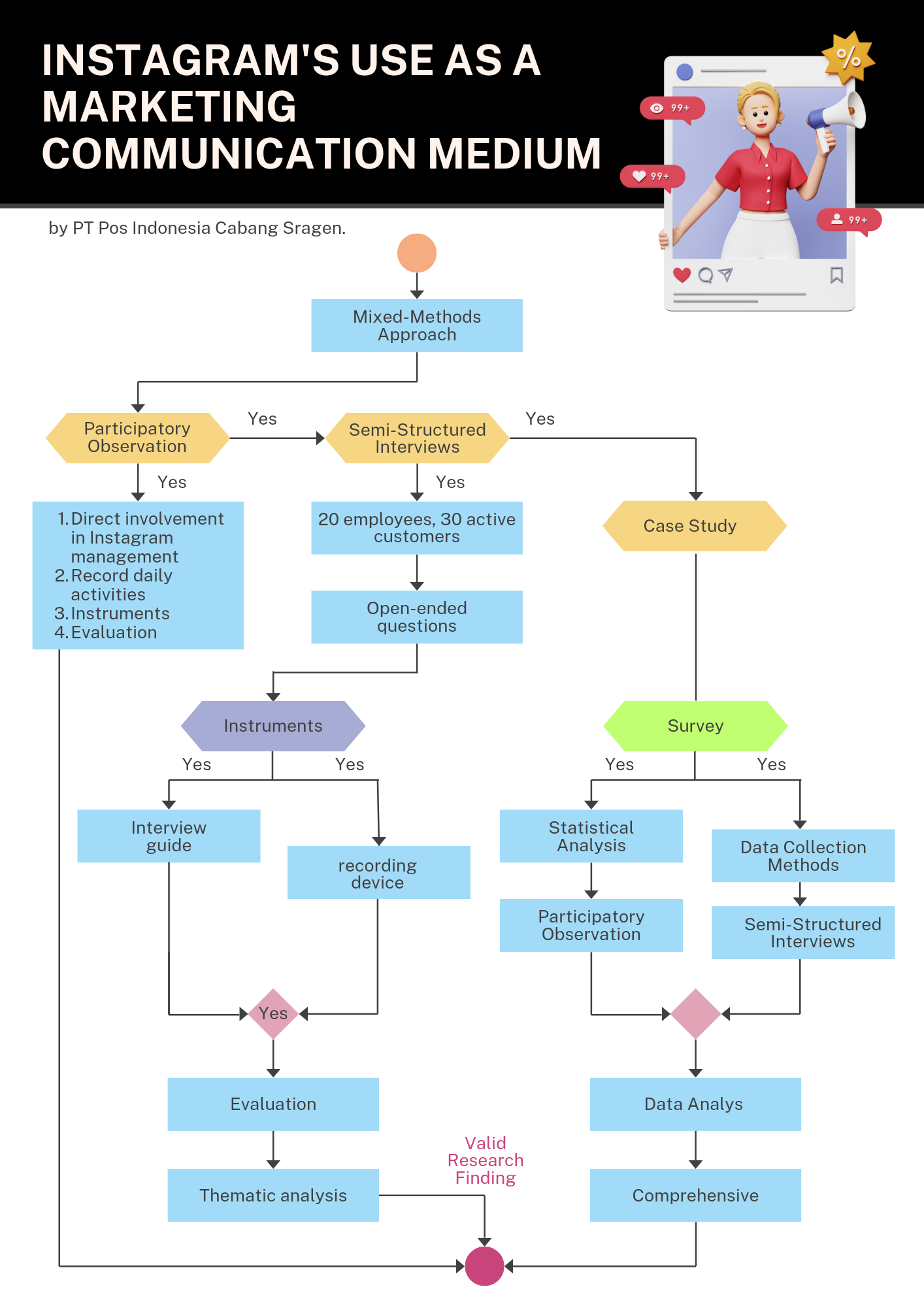Keywords: Instagram, Marketing communications, PT Pos Indonesia, Qualitative research
Abstract
Instagram is one of the social media most frequently accessed by internet users, so PT Pos Indonesia Sragen Branch, which operates in the expedition and financial services sector, uses Instagram as a marketing communications platform to introduce products and services to increase company sales. This research aims to identify and describe the use of social media Instagram @posaja_sragen as a marketing communication medium in introducing the products and services of PT Pos Indonesia Sragen Branch based on the marketing communication mix theory of Philip Kotler and Keller. This research focuses on the main problem faced by companies, namely the lack of public awareness regarding the products and services offered due to the limitations of conventional promotional media. The approach used in this research is qualitative with descriptive methods. Data collection techniques include observation, in-depth interviews with 10 employees and 15 customers, as well as documentation over three months. Data analysis was carried out through data reduction, data presentation, and conclusion, with data validity and reliability maintained through triangulation of sources and methods. The research results show that PT Pos Indonesia Sragen Branch has made optimal use of Instagram features, such as feeds, captions, Instagram stories, reels, hashtags, and direct messages (DMs) to introduce products and services. For example, using reels to show a fast and safe delivery process, as well as stories to promote discounts on delivery services. This strategy has proven effective in increasing engagement and interaction with customers, which is reflected in an increase in the number of followers by 25% and interactions on each post by 30%. The main benefits of using Instagram as a marketing communications medium include reducing promotional costs, ease of introducing service products, expanding communication facilities with the target market, and increasing company sales. This research concludes that the use of Instagram by PT Pos Indonesia Sragen Branch as a marketing communications medium has had a significant positive impact. As a recommendation, other companies are advised to adopt similar strategies with adjustments to suit their specific needs to maximize the potential of social media in their marketing strategies.
References
Abbas, A. A. (2021). Toward Successful Social Media Viral Marketing: A Knowledge Management Approach. Lecture Notes in Networks and Systems, 194, 377–389. https://doi.org/10.1007/978-3-030-69221-6_28
Abri, D. Al. (2020). Diversified viral marketing: The power of sharing over multiple online social networks. Knowledge-Based Systems, 193. https://doi.org/10.1016/j.knosys.2019.105430
Amperawati, E. D. (2024). Investigating the role of viral marketing, and brand awareness on purchase decisions: An empirical study in Indonesian online shops. International Journal of Data and Network Science, 8(3), 1715–1726. https://doi.org/10.5267/j.ijdns.2024.2.016
Aryaseta, A. W., Rosidah, I., Cahaya, V. E., Dausat, J., & Darmayanti, R. (2023). Digital Marketing: Optimization of Uniwara Pasuruan Students to Encourage UMKM" Jamu Kebonagung" Through Branding Strategy. Jurnal Dedikasi, 20(2), 13–23.
Asher, E. M., Morris, N. P., McNiel, D. E., & Binder, R. L. (2024). The Forensic Mental Health Implications of Social Media Challenges. The Journal of the American Academy of Psychiatry and the Law, 52(1), 80–89. https://doi.org/10.29158/JAAPL.230114-23
Awad, K. R., Abbas, S. H., & Obed, M. K. (2024). Analysis of the relationship between some indicators of sustainable development and economic growth in Iraq for the period (2004-2020). Revenue Journal: Management and Entrepreneurship, 2.
Bilgin, E., & Wang, Q. (2024). The mnemonic effect of central and peripheral misinformation on social media. Memory (Hove, England), 32(3), 369–382. https://doi.org/10.1080/09658211.2024.2323935
Bodie, G. D., & Dutta, M. J. (2008). Understanding health literacy for strategic health marketing: eHealth literacy, health disparities, and the digital divide. Health Marketing Quarterly, 25(1), 175–203. https://doi.org/10.1080/07359680802126301
Bragg, M., Lutfeali, S., Greene, T., Osterman, J., & Dalton, M. (2021). How Food Marketing on Instagram Shapes Adolescents’ Food Preferences: Online Randomized Trial. Journal of Medical Internet Research, 23(10). https://doi.org/10.2196/28689
Budiarti, E. (2024). Exploratory activities for early childhood: Utilizing smartphone technology to enhance early childhood creativity, effective? Assyfa Journal of Multidisciplinary Education, 1.
Cassidy, O., Shin, H. W., Song, E., Jiang, E., Harri, R., Cano, C., Vedanthan, R., Ogedegbe, G., & Bragg, M. (2021). Comparing McDonald’s food marketing practices on official Instagram accounts across 15 countries. BMJ Nutrition, Prevention & Health, 4(2), 510–518. https://doi.org/10.1136/bmjnph-2021-000229
Chan, R. H. W., Dong, D., Yu, J., & Kim, J. H. (2024). Who is being targeted by alcohol social media marketing? A study of Chinese young adults in Hong Kong. Drug and Alcohol Review. https://doi.org/10.1111/dar.13892
Correia, C. (2023). Viral Marketing: How Squid Game Became the Most Watched Show on Netflix. Springer Series in Design and Innovation, 27, 566–580. https://doi.org/10.1007/978-3-031-20364-0_48
Dahliani, L., Arshad, I., & Usmiyatun, U. (2024). Indonesian sugarcane crops have a variety of virus-carrying insects. What are their control methods? Revenue Journal: Management and Entrepreneurship, 2.
Dahliani, L., Shumaila, S., & Darmayanti, R. (2023). A Completely Randomized Design (CRD) for Tomato Plant Growth and Production on Different Planting Media. Assyfa Journal of Farming and Agriculture, 1, 8–13.
Danowski, J., Riopelle, K., & Yan, B. (2024). Cascaded Semantic Fractionation for identifying a domain in social media. Frontiers in Research Metrics and Analytics, 9, 1189099. https://doi.org/10.3389/frma.2024.1189099
Darmayanti, R., Effendi, M. M., Hasanah, N., & In’am, A. (2022). Development of Ethnomathematical Media Based on the Book Creator Application on the Syawalan Tradition in the Junior High School Curriculum. Al-Ishlah: Jurnal Pendidikan, 14(4), 6181–6196.
Darmayanti, R., Milshteyn, Y., & Kashap, A. M. (2023). Green economy, sustainability and implementation before, during, and after the covid-19 pandemic in Indonesia. Revenue Journal: Management and Entrepreneurship, 1, 27–33.
de Hesselle, L. C., & Montag, C. (2024). Effects of a 14-day social media abstinence on mental health and well-being: results from an experimental study. BMC Psychology, 12(1), 141. https://doi.org/10.1186/s40359-024-01611-1
DeBar, L. L., Schneider, M., Ford, E. G., Hernandez, A. E., Showell, B., Drews, K. L., Moe, E. L., Gillis, B., Jessup, A. N., Stadler, D. D., & White, M. (2009). Social marketing-based communications to integrate and support the HEALTHY study intervention. International Journal of Obesity (2005), 33. https://doi.org/10.1038/ijo.2009.117
Djuharni, D., Nursaid, N., & Sonhaji, S. (2024). Law enforcement and auditors’ roles, responses, and complicated relationships in accounting fraud? Revenue Journal: Management and Entrepreneurship, 2.
Dullah, M., Limgiani, L., & Suwardi, L. A. (2024). Work environment analysis to improve employee performance. Revenue Journal: Management and Entrepreneurship, 2.
Evans, W. D., Bingenheimer, J., Cantrell, J., Kreslake, J., Tulsiani, S., Ichimiya, M., D’Esterre, A. P., Gerard, R., Martin, M., & Hair, E. C. (2024). Effects of a Social Media Intervention on Vaping Intentions: Randomized Dose-Response Experiment. Journal of Medical Internet Research, 26. https://doi.org/10.2196/50741
Fauza, M. R., Effendi, M. M., & Lony, A. (2023). Analisis Minat Siswa dalam Menggunakan Instagram Sebagai Sumber Media Pembelajaran Matematika. JEMS: Jurnal Edukasi Matematika Dan Sains, 11(1), 49–57.
Fjelldal, I. K. (2022). Profanity in viral tourism marketing: A conceptual model of destination image reinforcement. Journal of Vacation Marketing, 28(1), 52–63. https://doi.org/10.1177/13567667211020497
Gurin, C. B. (1996). Integrated communications: fund raising, marketing, and public relations. Journal (Association for Healthcare Philanthropy (U.S.)), 39–40.
Gurler, D., & Buyukceran, I. (2022). Assessment of the Medical Reliability of Videos on Social Media: Detailed Analysis of the Quality and Usability of Four Social Media Platforms (Facebook, Instagram, Twitter, and YouTube). Healthcare (Basel, Switzerland), 10(10). https://doi.org/10.3390/healthcare10101836
Haanurat, A. I., Vedianty, A. S. A., & Tollentino, S. A. (2024). Instagram’s impact on sharia economic law literacy in the digital age and Indonesia’s sharia economy strengthening. Revenue Journal: Management and Entrepreneurship, 2.
Hendarto, T., Haanurat, A. I., & Dhakal, A. (2023). Does TQM affect Indonesian food sector production efficiently? Revenue Journal: Management and Entrepreneurship, 1, 44–50.
Hendarto, T., Nursaid, N., & Nadaroglu, H. (2024). Retail Companies: The Impact of Brand Image, Advertising, Promotional, and Capital Spending on Financial Performance. Revenue Journal: Management and Entrepreneurship, 2.
Herrmann, L., Barkmann, C., Bindt, C., Hohmann, S., Fahrenkrug, S., & Becker-Hebly, I. (2024). How social is social media for transgender and gender-diverse youth? Association of online social experiences with internalizing mental health problems. European Child & Adolescent Psychiatry. https://doi.org/10.1007/s00787-024-02396-9
Ho, V., Nguyen, A., & Kumar, K. (2024). Social media for learning: A qualitative exploration of the factors that impact clinical learners’ attitudes and intentions. The Clinical Teacher. https://doi.org/10.1111/tct.13760
Hooper, R., Guest, E., Ramsey-Wade, C., & Slater, A. (2024). A brief mindfulness meditation can ameliorate the effects of exposure to idealised social media images on self-esteem, mood, and body appreciation in young women: An online randomised controlled experiment. Body Image, 49, 101702. https://doi.org/10.1016/j.bodyim.2024.101702
Isbulan, O., Cam, E., & Griffiths, M. D. (2024). The mediating effect of social network identity management on the relationship between personality traits and social media addiction among pre-service teachers. BMC Psychology, 12(1), 146. https://doi.org/10.1186/s40359-024-01653-5
Ituarte, B. E., Sharma, D., Fernandez, J. M., Wysong, A., & Wei, E. X. (2024). A cross-sectional analysis of social media searches for popular hidradenitis suppurativa treatments using Facebook, Reddit, and Google Trends. International Wound Journal, 21(3). https://doi.org/10.1111/iwj.14725
Johnson, A. J., Wharton, B. R., Geraghty, E. H., Bradsell, H., Ishikawa, A., McCarty, E. C., Bravman, J. T., & Frank, R. M. (2024). Patient Perception of Social Media Use by Orthopaedic Surgeons: A Pilot Study. Orthopaedic Journal of Sports Medicine, 12(3), 2147483647. https://doi.org/10.1177/23259671241232707
Johnson, A., Khan, S., & Koo, E. B. (2021). Social media and vision therapy: Perspectives of providers and patients on Instagram. Journal of AAPOS : The Official Publication of the American Association for Pediatric Ophthalmology and Strabismus, 25(3), 166. https://doi.org/10.1016/j.jaapos.2020.11.023
Khalaf, A. Z., & Hamad, S. Ben. (2023). An exploratory and analytical study of a sample of control and audit professionals’ opinions on green audit techniques and methods. Revenue Journal: Management and Entrepreneurship, 1, 11–17.
Khan, I. F., Garza, H. D. La, Lazar, M., Kennedy, K. F., & Vashi, N. A. (2024). Effects of the COVID-19 Pandemic On Patient Social Media Use and Acceptance of Cosmetic Procedures. The Journal of Clinical and Aesthetic Dermatology, 17(3), 42–47.
Krings, W. (2021). Industrial marketing management digital media optimization for B2B marketing. Industrial Marketing Management, 93, 174–186. https://doi.org/10.1016/j.indmarman.2021.01.002
Krishnan, C. (2022). Viral Marketing: A New Horizon and Emerging Challenges. Smart Innovation, Systems and Technologies, 246, 161–175. https://doi.org/10.1007/978-981-16-3398-0_8
Kusumaningsih, D., Darmayanti, R., & Latipun, L. (2024). Mendeley Software improves students’ scientific writing: Mentorship and training. Jurnal Inovasi Dan Pengembangan Hasil Pengabdian Masyarakat, 2(1).
Li, Y.-T., Chen, M.-L., & Lee, H.-W. (2024). Health communication on social media at the early stage of the pandemic: Examining health professionals’ COVID-19 related tweets. Social Science & Medicine (1982), 347, 116748. https://doi.org/10.1016/j.socscimed.2024.116748
Lim, H. W. (2018). Comments on “Plastic Surgery-Related Hashtag Utilization on Instagram: Implications for Education and Marketing.” Aesthetic Surgery Journal, 38(8). https://doi.org/10.1093/asj/sjx228
Liu, D., He, B., Feng, R., Huang, X., & Liu, G. (2024). How social media sharing drives consumption intention: the role of social media envy and social comparison orientation. BMC Psychology, 12(1), 157. https://doi.org/10.1186/s40359-024-01627-7
Malesev, S. (2021). Digital and social media marketing-growing market share for construction smes. Construction Economics and Building, 21(1), 65–82. https://doi.org/10.5130/AJCEB.v21i1.7521
Malik, M., Bauer-Maison, N., Guarna, G., & D’Souza, R. D. (2024). Social Media Misinformation about Pregnancy and COVID-19 Vaccines: A Systematic Review. Medical Principles and Practice : International Journal of the Kuwait University, Health Science Centre, 33(3), 232–241. https://doi.org/10.1159/000538346
Malodia, S. (2022). Meme marketing: How can marketers drive better engagement using viral memes? Psychology and Marketing, 39(9), 1775–1801. https://doi.org/10.1002/mar.21702
McArt, J. A. A. (2024). A note from the Editor in Chief of JDS Communications: Elevating science via social media. JDS Communications, 5(2), 89–90. https://doi.org/10.3168/jdsc.2024-0553
Murphy, A., & Groves, A. (2024). “Pretty Women” and “Lucky Blokes”: Unpacking Australian Social Media Responses to Female-Perpetrated Sexual Assault Against Men. Journal of Interpersonal Violence, 2147483647. https://doi.org/10.1177/08862605241239446
Nursaid, N. (2024). Integrated and systematic Best Practices of" Financial Management in Education" in Southeast Asia. Revenue Journal: Management and Entrepreneurship, 1.
Nursaid, N., Nuraini, S., & Novitasari, D. R. (2024). How" influence" do media, facilities, and learning interests influence students’ economic learning outcomes? Assyfa Journal of Multidisciplinary Education, 1.
Nursaid, N., Smith, Z., & Dhakal, A. (2023). Development of Islamic economics and practices in Indonesia (2013-2023): opportunities and challenges. Revenue Journal: Management and Entrepreneurship, 1.
Nursaid, N., Zamil, R., & Labh, A. (2024). Sustainable and just economy: One Islamic boarding school, one product program for economic empowerment. Revenue Journal: Management and Entrepreneurship, 2.
Phillips, K., Stewart, C., Johnston, T., & Mills, D. S. (2024). “Have You Seen This Drivel?” A Comparison of How Common Health Issues Are Discussed within Brachycephalic and Non-Brachycephalic Dog Breed Groups on Social Media. Animals : An Open Access Journal from MDPI, 14(5). https://doi.org/10.3390/ani14050757
Philteos, J., Madan, Y., James, A. L., Propst, E. J., Ostrow, O., McKinnon, N., Everett, T., Siu, J., & Wolter, N. E. (2024). Public knowledge of button battery ingestions: A social media based cross-sectional analysis. International Journal of Pediatric Otorhinolaryngology, 179, 111902. https://doi.org/10.1016/j.ijporl.2024.111902
Potts, L., & Rowitz, L. (1996). Social marketing/health communications: leadership opportunities for the 1990s. Journal of Public Health Management and Practice : JPHMP, 2(4), 73–76. https://doi.org/10.1097/00124784-199623000-00019
Pourkarim, M. (2022). Digital Marketing: A Unique Multidisciplinary Approach towards the Elimination of Viral Hepatitis. Pathogens, 11(6). https://doi.org/10.3390/pathogens11060626
Roberts, S. R., & Brown, T. A. (2024). Introduction to the special issue on the influence of social media on body image and disordered eating. Eating Behaviors, 53, 101862. https://doi.org/10.1016/j.eatbeh.2024.101862
Rodgers, R. F., Hewett, R. C., & Nowicki, G. P. (2024). A sociocultural model of the relationships between social media use and body image in midlife women. Eating Behaviors, 53, 101867. https://doi.org/10.1016/j.eatbeh.2024.101867
Romano, M. (2005). Spin cycles. Healthcare marketing-communications efforts have taken on increasing strategic importance. Modern Healthcare, 35(47), 28–30.
Rossi, N. A., Devarajan, K., Chokshi, S. N., Ochoa, V. J., Benavidez, M., Malaya, L. T., Ohlstein, J. F., Young, D. L., & McKinnon, B. J. (2023). Social Media Depictions of Cochlear Implants: An Instagram and TikTok Analysis. Otology & Neurotology : Official Publication of the American Otological Society, American Neurotology Society [and] European Academy of Otology and Neurotology, 44(1). https://doi.org/10.1097/MAO.0000000000003744
Schierle, C. (2018). Response to “Comments on ‘Plastic Surgery-Related Hashtag Utilization on Instagram: Implications for Education and Marketing.’” Aesthetic Surgery Journal, 38(8). https://doi.org/10.1093/asj/sjy120
Shabahang, R., Kim, S., Aruguete, M. S., Azadimanesh, P., Ghaemi, Z., Khanzadeh, A. A. H., Kakabaraee, K., & Zsila, Á. (2024). Social media-related nightmare - a potential explanation for poor sleep quality and low affective well-being in the social media era? BMC Psychology, 12(1), 140. https://doi.org/10.1186/s40359-024-01605-z
Shamim, K. (2022). Digital influencer marketing: How message credibility and media credibility affect trust and impulsive buying. Journal of Global Scholars of Marketing Science: Bridging Asia and the World, 32(4), 601–626. https://doi.org/10.1080/21639159.2022.2052342
Sharma, R. R. (2020). E-mail viral marketing: modeling the determinants of creation of “viral infection.” Management Decision, 58(1), 112–128. https://doi.org/10.1108/MD-03-2017-0215
Smith, J., & O’Shea, B. (2024). Social media can adversely impact young peoples’ risk-taking behaviours. Evidence-Based Nursing. https://doi.org/10.1136/ebnurs-2024-103951
Solehudin, R. H., & Darmayanti, R. (2018). Does token economy behaviour modification affect young children’s discipline? Jurnal Caksana: Pendidikan Anak Usia Dini, 1(2), 202–215.
Subramanian, A., Kodavati, K. P., Kanchustambam, J., & Gothwal, V. K. (2024). Social media use and vision impairment in adults between the ages of 18 and 35 years in India. Optometry and Vision Science : Official Publication of the American Academy of Optometry, 101(6), 329–335. https://doi.org/10.1097/OPX.0000000000002098
Sudiantini, D., Rizky, P. P., & Hazarika, A. (2023). Digital economy and financial inclusion in reviving the national economy: A Management Strategy. Revenue Journal: Management and Entrepreneurship, 1.
Sungkawati, E. (2024). Opportunities and Challenges: Adopting “Blue-Green Economy†Terms to Achieve SDGs. Revenue Journal: Management and Entrepreneurship, 1, 1–13.
Sungkawati, E., Novitasari, D. R., & Hamad, S. Ben. (2024). Viral Marketing: Mixue the King of Snow Ice Cream—How does this franchise affect the market? Revenue Journal: Management and Entrepreneurship, 2.
Sungkawati, E., Usmiyatun, U., & Karim, S. (2023). “ Improving” food processing skills by creating new entrepreneurs. Revenue Journal: Management and Entrepreneurship, 1.
Szeto, M. D., Presley, C. L., Pulsipher, K. J., Harp, T., Rundle, C. W., Sivesind, T. E., Laughter, M. R., & Dellavalle, R. P. (2021). Dermatologist influencers on social media: Instagram Reels and TikTok interactive short videos. Journal of the American Academy of Dermatology, 85(3). https://doi.org/10.1016/j.jaad.2021.04.052
Triono, T., Darmayanti, R., & Saputra, N. D. (2023). Vos Viewer and Publish or Perish: Instruction and assistance in using both applications to enable the development of research mapping. Jurnal Dedikasi, 20(2).
Troise, C. (2021). The Use of Digital Media for Marketing, CSR Communication and Stakeholder Engagement. Strategic Corporate Communication in the Digital Age, 161–174. https://doi.org/10.1108/978-1-80071-264-520211010
Tu, S. (2022). A Viral Marketing-Based Model For Opinion Dynamics in Online Social Networks. WWW 2022 - Proceedings of the ACM Web Conference 2022, 1570–1578. https://doi.org/10.1145/3485447.3512203
Vidyastuti, A. N., Effendi, M. M., & Darmayanti, R. (2022). Aplikasi tik-tok: Pengembangan media pembelajaran matematika materi barisan dan deret untuk meningkatkan minat belajar siswa SMA. Jurnal Math Educator Nusantara: Wahana Publikasi Karya Tulis Ilmiah Di ….
Widodo, T., Muhammad, I., Darmayanti, R., Nursaid, N., & Amany, D. A. L. (2023). Manajemen keuangan pendidikan berbasis digital: Sebuah kajian pustaka. Indonesian Journal of Educational Management and Leadership, 1(2), 146–167.
Wong, L. W. (2022). Mobile social media marketing: a new marketing channel among digital natives in higher education? Journal of Marketing for Higher Education, 32(1), 113–137. https://doi.org/10.1080/08841241.2020.1834486
Wu, M., Wu, T., & Pei, Y. (2024). What Drives Health Information Exchange on Social Media? Social Media Affordances and Social Support Perspectives. Health Communication, 1–15. https://doi.org/10.1080/10410236.2024.2321408
Yuniwati, E. D., Novitasari, D. R., & Kamran, A. (2023). Alternative waste management: composting and biochar conversion for metal remediation. Revenue Journal: Management and Entrepreneurship, 1, 34–43.
Zamzam, R., Novitasari, D. R., & Suharsiwi, S. (2024). “ RAISE” exploration of science challenges and cultural values improves learning outcomes. Assyfa Journal of Multidisciplinary Education, 1.
Zhang, T. (2022). Viral marketing: influencer marketing pivots in tourism–a case study of meme influencer instigated travel interest surge. Current Issues in Tourism, 25(4), 508–515. https://doi.org/10.1080/13683500.2021.1910214
Zhang, Z., & Cheng, Z. (2024). Users’ unverified information-sharing behavior on social media: The role of reasoned and social reactive pathways. Acta Psychologica, 245, 104215. https://doi.org/10.1016/j.actpsy.2024.104215

Published
How to Cite
Issue
Section
License
Copyright (c) 2024 Ellen Ira Ardiana, Joko Suryono, Betty Gama, Bono Setyo

This work is licensed under a Creative Commons Attribution-ShareAlike 4.0 International License.

 https://doi.org/10.61650/rjme.v2i1.490
https://doi.org/10.61650/rjme.v2i1.490

